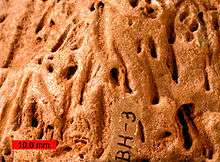Skolithos
| Skolithos | |
|---|---|
 | |
| Skolithos trace fossils. Scale bar is 10 mm. | |
| Trace fossil classification | |
| Ichnogenus: | Skolithos |
Skolithos (formerly spelled Scolithus or Skolithus[1]) is a common trace fossil ichnogenus that is, or was originally, an approximately vertical cylindrical burrow. They can reach lengths of up to about 35 cm[2] (14") and diameters of up to about 5 cm (1.6").[2]
Skolithos burrows range in age from early Cambrian[3] to the present[4][5] and are found throughout the world. They occur in sediments and sedimentary rocks, primarily sands and sandstones. They are typically marine in origin,[6] and are commonly associated with high-energy environments close to the shoreline.[3] They have also been reported from freshwater lacustrine settings,[2] but have rarely been described from carbonate rocks.[7]
The famous "Pipe Rock" of northwest Scotland is a well-known example of Skolithos. The 'pipes' that give the rock its name are closely packed straight Skolithos tubes that were presumably made by a worm-like organism.[8] Skolithos linearis, found in the Blue Ridge Mountain region, is the oldest known trace fossil in Virginia.[9]
Trypanites is similar in form but is excavated in hard substrates. Also somewhat similar are Ophiomorpha and Diplocraterion.
References
- ↑ Gevers, T.W.; Frakes, L.A.; Edwards, L.N.; Marzolf, J.E. (1971). "Trace Fossils in the Lower Beacon Sediments (Devonian), Darwin Mountains, Southern Victoria Land, Antarctica". Journal of Paleontology. 45 (1): 81–94. JSTOR 1302754.
- 1 2 3 Woolfe, K.J. (1990). "Trace fossils as paleoenvironmental indicators in the Taylor Group (Devonian) of Antarctica". Palaeogeography, Palaeoclimatology, Palaeoecology. 80 (3–4): 301–310. doi:10.1016/0031-0182(90)90139-X.
- 1 2 Desjardins, P. R.; Mángano, M.G.; Buatois, L. A.; Pratt, B. R. (2010). "Skolithos pipe rock and associated ichnofabrics from the southern Rocky Mountains, Canada: colonization trends and environmental controls in an early Cambrian sand-sheet complex". Lethaia. 43 (4): 507. doi:10.1111/j.1502-3931.2009.00214.x.
- ↑ Pemberton, S.G. and Frey, R.W. 1985. The Glossifungites ichnofacies: modern examples from the Georgia coast, U.S.A. In: Curran, H.A. (ed.), Biogenic structures: their use in interpreting depositional environments. Society of Economic Paleontologists and Mineralogists, Special Publication 35, p. 237-259.
- ↑ Gingras, M.K., Pemberton, S.G., Saunders, T. and Clifton, H.E. 1999. The ichnology of modern and Pleistocene brackish-water deposits at Willapa Bay, Washington; variability in estuarine settings. Palaios, vol. 14, no. 4, p. 352-374.
- ↑ Trewin, N.H.; McNamara, K.J. (1995). "Arthropods invade the land: trace fossils and palaeoenvironments of the Tumblagooda Sandstone (? late Silurian) of Kalbarri, Western Australia". Transactions of the Royal Society of Edinburgh: Earth Sciences. 85: 177–210. doi:10.1017/s026359330000359x.
- ↑ Vinn, O.; Wilson, M.A. (2013). "An event bed with abundant Skolithos burrows from the late Pridoli (Silurian) of Saaremaa (Estonia)". Carnets de Géologie. CG2013_L02: 83–87. doi:10.4267/2042/49316. Retrieved 2013-04-04.
- ↑ Hallam, A. and Swett, K. Trace fossils from the Lower Cambrian pipe rock of the north-west highlands. Scottish Journal of Geology, vol. 2, p. 101-107.
- ↑ "Blue Ridge". geology.blogs.wm.edu. Retrieved 2017-02-04.
External links
